

M - 3M - 3W
CHAPTER
76 (Sept 2014) ![]() INDEX
TO OTHER PAGES
INDEX
TO OTHER PAGES
What an odd heading to spell; M - 3M - 3W, yet it summarizes natures fundamentals. But first; on our last page we had some questions, some of which are already answered and some I did not plan to answer.
But seeing it is written: Vanity O vanity, to search out secrets is a torturous task which God has given the children of man to therewith pain himself." I am one of those whose appetite for knowledge is unquenchable, and by that I am driven to pain myself some more.
We wanted to know how the atoms as magnetic entities come to join to one another, and how and by what they will push themselves away from each other. Like when water is heated becoming steam, our question is: How and why do they do so?
And when water freezes into ice; what is it that occurs for these atoms to do so? For if we had some factual answers to these, the same might be true for gasoline, and other such liquids to expand when a spark is introduced into them.
While then I have spoken of many things to which there are no doubts, nature itself confirming them, there are likewise other things that we merely speculate upon. For unless and until something is well confirmed by all that is observed in due evidence, we ought not take them as facts.
We can be sure of this; that the atoms are not moved electrically, wherefore it becomes a confirmed fact that it must be in a magnetic nature. The reason that we can be so sure of this, is because there is none other, no other phenomena in nature to move things by the linear.
But now comes the real problem in how these atoms perform these functions magnetically, for us to explain the how and why, other than that we know it to be in the nature of magnetic.
Since then on occasion I preach to you my heartfelt insight, like as pronouncing to you that magnets and magnets may be different things, how the atom as a magnet, is not quite the same as those magnets that are manufactured.
And so my words ought to make out when I am pronouncing that which I believe, verses my reasoning utilizing the phenomena of nature as evidence to what we may be defining. Since then I did asked the questions -- it is because I do not have all the answers, or else I might not have stated the question.
Yet I have this inner vision if you will that there are three versions of magnetic, the magnet as linear, the electric as rotational, and the atom in a combination thereof.
Let us proceed to illustration Figure 75-1. There are two atoms, and so let me relate to you how I envision the atom. No protons, and no electrons, nor neutrons, nor quarks, or whatever else man has come up with. And having pronounced the substance in the term of "finite dust," at this time let us attempt to improve upon it.
As you view the atoms here, notice how it is darker in the center and lighter as we move outward, and still lighter to the edges. Consequently I do not view the atom as having a specific core with other parts encircling it, but rather the atom as one single whole. And that it is more condensed near the center of it.

And now to give it a name when there really is no name. For how am I to name a substance which I do not know as a substance? But to use something in likeness of, that as such may only be a figure of speech, let's name it "water."
The reason then I said "water," is because the Lord spoke of what He created as water saying: "Let there be a firmament in the midst of the waters, and let it separate the waters from the waters." As then we in speaking of water relate it to H2O, we are not here speaking of that kind of water.
But we are speaking of a substance, if it is a substance. Wherefore I determined to name it by 3W. The "W" stands for water, and the 3 in relevance to the 3 of the 3M, with the 3M being none other than magnetic motion.
As then we write out M - 3M - 3W, we are speaking of "Matter in Motion by Coordination." The M is movement, as the "Motion," the 3W, then is as "Matter," with the 3M, as the factor of coordinates.
This term then lends itself better to the substance of the universe, found in all atoms, since water is not a solid, nor is it a gas. For so I envision it completely porous and open to all movements to enter within and upon it.
I however must explain this better so my reader won't get the wrong idea. When you take a steel bar, the movement of 3M goes right through it as were it hollow with nothing to stop it. This is because that bar is nothing more than a grid of atoms perfectly suited to conduct all such movements.
But when we get to the atom, there are no atoms within the atom, and if it were a solid how would the 3M enter into it? It might conduct itself upon the outer edges, but how then would the atom become anything in the nature of magnetic?
Movement now must be upon movement in order to create movement. But this is a mouthful is it not? And I believe I mentioned something of this nature in a previous page. For the time being however I believe this ideal of 3W suits the atom better than anything else I can think of.
3W then is the W of water, with a 3 to denote that it is not water as water. And why the 3? Don't ask. But to get to the rest of it, there was a question as to how atoms may hold onto one another. And while that is very simple with regular magnets, we are not speaking of regular magnets.
There is in fact a day and night difference between them. Regular magnets do not spin, nor therefore is their magnetic figure of eight in a rotating condition. These kind of magnets are stationary objects, and while the earth as a magnet may be spinning, it spins too slow to be listed other than with the stationary types.
In our illustration Figure 75-1, both atoms are spinning as their axis indicate, and for our purpose they may be spinning into any direction that we wish. It is rather in their relative positioning that we are interested.
For as they spin their lines at the equatorial region are facing and matching each other. Their direction of movement from anyone of the areas at "A" proceeds to areas "B." And not only each to their own, but each one to the other as well.
This is so since 3M movement is conductive. Therefore also do they link with one another, and more so, since there is a crossing between them, noted by the "X". Two atoms may thus be held to one another in this fashion. And/or when the velocity of their movement is increased - to be driven to a greater distance from one another.
And by the same token when the velocity is reduced to link more ridged to one another, up to a point where neither one is able to come closer to the other, prevented by either their movement in the wake of (to put it that way) or their outer shell, all of which is still movement to movement.
And further more, the area between the atoms appear like a magnetic entity, the figure eight of movement, with C, as the South, and D, the North.
![]() This
looks pretty fancy does it not? Or even logical. But what confirmation can we
bring to it? Well, there is the moon as it orbits the earth, and the earth
orbiting the sun in a fashion like unto it. For it is not from pole to pole
that the moon orbits earth.
This
looks pretty fancy does it not? Or even logical. But what confirmation can we
bring to it? Well, there is the moon as it orbits the earth, and the earth
orbiting the sun in a fashion like unto it. For it is not from pole to pole
that the moon orbits earth.
Illustration Figure 16-2, demonstrates the lines of 3M as they pass over the moon, and the moon for its velocity attempting to get away from us - is held by these lines, and as it does - it elongates those lines of the 3M that are between the earth and the moon.
The earth then rotates wherefore its lines of 3M are going with that rotation. Whereas for the moon since it does not rotate, its lines of 3M are always stationary, and always elongated where it faces the earth.
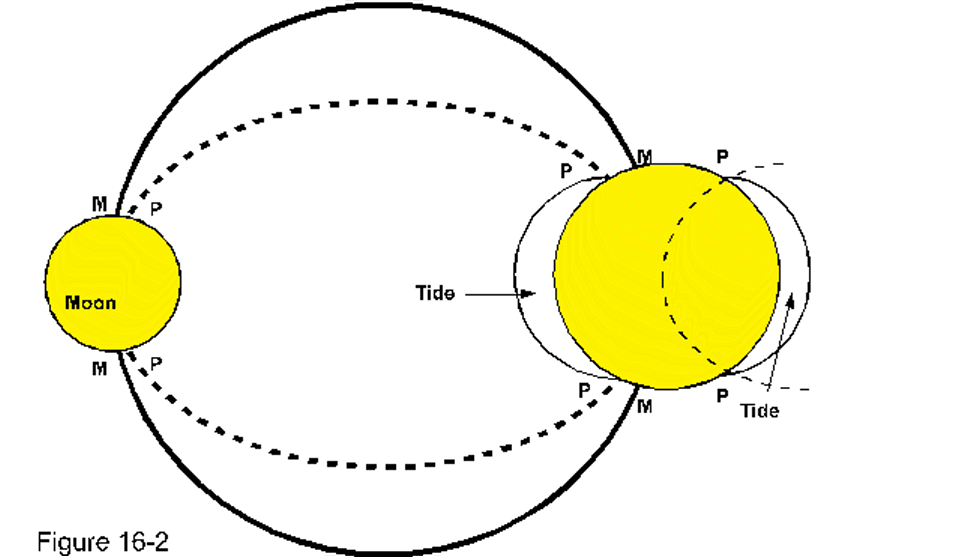
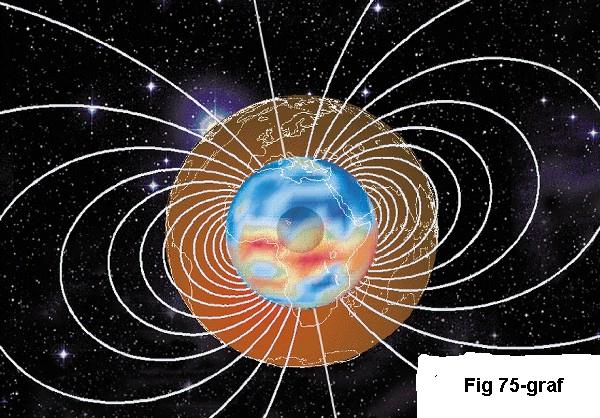
If then my reader here has not as yet understood the norm of gravity, I found an illustration to show the extend of gravity around the earth. It being limited in distance from the earth, like the brown in Fig 75-graf, around the earth.
Gravity for its pull of diminishes as we go outwards. By the calculations obtained from the Hubble telescope it comes to less the 3500 miles, while the moon is at a distance exceeding 240,000 miles.
Logically the moon can not be held gravitational. And since it is magnetically we are able to have our tides, on both sides of our earth simultaneously.
My point with the atom then is, that if magnetic entities such as planets are held by the loops of the 3M, why should that not be possible with the atoms as well? And yes I know the differences, how the planets keep from falling into the sun by their orbital velocities.
But do we not have something like that with the atom as well, namely; their high speed of rotation. For if we question how water expands into steam, the answer is by heat, by a higher degree of movement, be it spin, or in the velocity of its coordinate, or by a combination of the two.
The little rascals are too small to be observed, and even then how is one to see motion, like to see the wind? We can feel it, or measure its movement, yes, but however strong our microscopes are, we have yet to see the atom as it operates.
Then there is this fact with magnets, when they are faced with like directions of movement, north to south as by Figure 75-2, H as north and G as south, they will clamp onto one another body to body.
Will then the atoms when so positioned clamp to one another H resting on G? Or will they go even deeper into one another seeing their substance is 3W? One thing seems a fact how these will not go so far as to become one, since they are two entities.
Just how close or how far then will they go? For unlike regular magnets, both of these atoms are turning at a high clip, the oval at K noting their rotation. Will thus their rotation keep them at a respectable distance? Perhaps they will come to look like the two atoms of oxygen illustrated here.
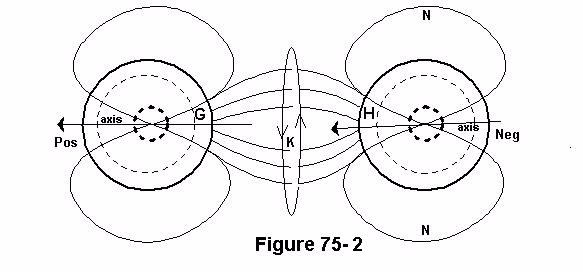
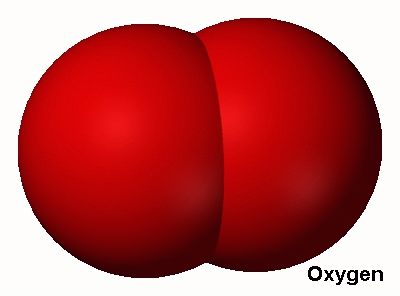
These atoms then could for all practical purposes be turning in like or opposite directions of one another. One thing in their favor is that they do not contain any component factors like regular magnets do. They as such are singular, and their coordinate in eight may not be quite the same.
With this I mean, not like the "over-all" coordinate that rests upon the earth and regular magnets. I spoke of this on page 61, (Figure 61-6).
But what the real facts are is yet to be determined. And so, are they like that Silicon illustrated here, or like the Hydrogen atom clamps onto the Oxygen in Figure 75-4?
![]()
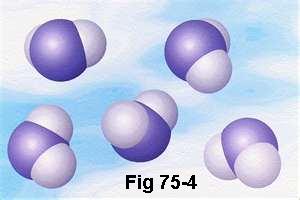
When we refer to Figure 75-3, there is one Oxygen atom with two of Hydrogen. As then the Oxygen atom is larger with a multiple coordinate it is holding on to the atoms of H by its linear flow, or linear power. H1 has it north to a south end of O, while H2 has its south to the north of O.
In an overall view one half of the Oxygen atom has an all incoming flow of movement noted M/minus, while M/plus indicates the outgoing flow of movement. Here thus we are not speaking of atom to atom by their equatorial loops but by their areas of polarity.
If then atoms can lock onto one another by any of these fashions, any one atom of the larger sizes can hold onto four or more atoms. As then Hydrogen is rather small it may be for that reason it can present only a single format.
Our reasoning then may be right, or it may be wrong, yet this much we do know that the M, and 3M movements are conductive. That is to say they will lock onto one another. But there is a flaw here in that it is not in the movement as such -- as it is in directions of.
For when these conductive movements are in opposite directions, they present themselves as none conductive, and yet conductive in drawing away from each other. So how phenomenal is this that these lines act as were there glue upon them to join with one another provided they are heading in the same direction?
There is of course no glue, nor anything electrical, nor as such magnetic with or upon these lines. And yet they are as such magnetic, because they are the 3M, the grant figure of eight, that draws and quells upon that which resides within its confines.
If per example we look at Saturn with its rings, where are these rings located if not within the loops of the planet's magnetic force? Illustrated by Figure 75-V. As such therefore we might say, that these rings are well confined within the embrace of the figure of eight.


It is mind boggling to realize how far the force of magnetic with its lines of are able to extend themselves, as if there were no end to them. Gravity itself by comparison is minute in distance, like the speed of sound to that of light, a day and night difference.
Nor, so it appears, are they dependent upon matter, yet very much susceptible to it. Whether there is empty space or solid matter they go through it just the same.
As now by a like direction of these lines of movement these do adhere, the shape of their formation changes accordingly - as illustrated by Figures 75-5 and 75-6. Fundamentally they are figures of eight, and as such very resilient to take on whatever shape is forced upon them.
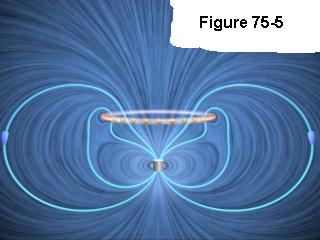
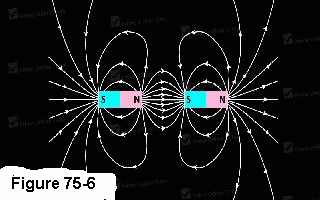
When we view the earth by its figure of eight, that as such is the "overall" coordinate. That overall coordinate then rests upon more individual coordinates of eight, as well as other coordinates. These in turn rest upon and are brought about by the atoms in their molecular structures.
Then we finally come to the atom, wherefore it is in three to four stages to go from the eight in the atom to the eight that encompasses the entire structure, be it a planet, a star, or a regular magnet.
By the next illustration Figure 75-7, however we have an erroneous idea - as if you can drive the format of eight from its equilibrium. There is no such thing, and the above illustration Fig 75-5, and fig 75-6 prove it conclusively. Fig 75-8, shows it correct.
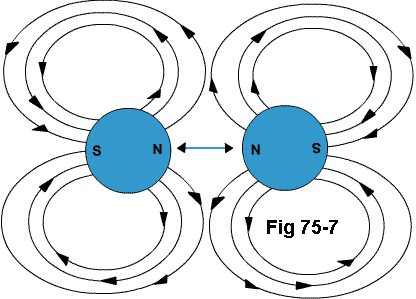

If now one thinks he has a pretty good idea about the atom, let me assure you that we are as yet a long way, yes, a very long way from knowing the atom.
When for example we take a metal bar, any kind of metal, how may it be that we do not notice any kind of magnetism, nor electrical? My meaning is, that whole bar being made up of magnets, their atoms as such being magnetic, why won't a nail draw towards a gold bar, or even to a plastic bar?
In our less than perfect view - magnets are magnets, - and anything that is susceptible to magnetic force should be drawn by it. If not so, we deem it none magnetic. And yet it is equally a fact that all atoms of any and all elements are after a magnetic nature.
There is no getting around to this, since the electrical kind as man's scientists have formulated are unable to latch onto one another. Nor therefore do we get jolted by touching any plastic, or our slice of bread, while all these substances, the sugar in your coffee, and the table cloth upon your table are constructed of atoms latching on to one another by what is understood as magnetic.
Their nature as such being like unto magnetic. But even more so as being a movement that is directionally conductive. And now here is a word is it not, to say; "Directionally conductive."
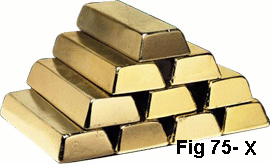
The answer to all this - as I have said before - there is magnetic and there is magnetic, as there are orders of nature, and magnitudes of nature. And so it was that previous to this time my preference in respect to the magnetic nature of the atom, I preferred to call it; "Conductive movement." But in all reality it is directionally conductive.
I then was forced to also label it as magnetic, all because man by his scientists had this idea as if these minute points in nature were holding themselves together electrically.
But now that the electric notion is well defeated, we want something more than that term of conductive. For here again, magnets in their overall form are also conductive, and so is electricity, and so are metals and a host of other substances, all conductive.
Wherefore we must be a bit more specific in using that term for the atom in its nature of. But how will we do so, or how shall we put it?
I must say that the eight of force within and upon the atom is not like that full figure of eight as it resides upon the earth. The atom after all is but a very tiny point in nature, with the scope of its internal movement equally no more than a point in nature.
It is in the "Overall" formation of force that we have our true or full magnetic, and electrical forces. For just because an atom rotates, does not make it electrical. And just because the coordinates within the atom are of a linear nature does not make them magnetic as we normally associate that term with.
To thus say that each atom is a magnet, is rather a figure of speech, for while their conductive movements track a linear power like as is found with magnets, does not per/say make them a magnet as we know magnets. There is after all a rotational, spinning movement wherein and whereby the linear format is born.
One might say, that it is the reverse of electrical, wherein the linear's are made to rotate, while in the atom it is rotation to produce linear force. Yet then again in the electrical if we did not twist a straight line by turning it, there would be no electric.
And it is so in nature that we do not necessarily have to have turns in movement, but that simple physical turns can also count as turns, that in turn account for turns in movement. Electricity furnishes us with ample evidence thereof.
Movement in circles accounts for movement, indeed so, but physical turns adds equally as much to movement. For as I once coined, that; "Turns add to turns, and turns compensates for turns." The same may be coined for movement; that; "Movement add to movement, and movement compensates for movement."
As then there are no straight lines with the atom, to turn these into a frenzy, there is no way for them to obtain electricity, as we know it to be. But there is that spinning of the atoms, which is an angular form of movement to create linear formats.
Not that the atom is capable of that all by itself, since I headed this page by saying M -3M -3W. If then at this stage of the game that sounds more like a riddle, then so be it.
And yes my dear reader I have a pretty good idea as to the nature of these, but difficult to put into words, and I am hesitant to put it into words since there are things I do not wish to reveal.
But I will say this; It is said that the most famous tale in science is E=mc2. This currently most famous fantasy will become one of the most absurd and infamous notes ever scribbled on paper.
And what will become most famous? (MMC) Mater in Motion by Coordination. as well as 3M, Vc, Vr, and magnetism as (DCM) Directionally Conductive Movement.
Nor will it be Einstein as the famous one, but by the grace of God it will be my name, with the name of Einstein in the gutter and thought of like the devil is thought of.
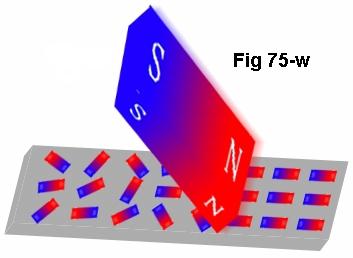
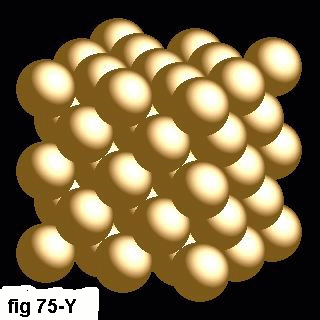
From what I have observed we in all this really have no idea as to how magnetic force works, nor how it is situated upon a metal bar, or upon the earth for that matter, or anywhere. Like the illustration Fig 75-W, when something is magnetized all the atoms come to align themselves.
But that is most contradictory, since all man's literature pronounces the atom to link by electrical rather than magnetic. Is it really so impossible for man to stick to just one woman, that he must lay claim on another as well? Meaning, to stick to his story either electrical, or magnetic?
And yes I know how man confuses one with the other, that when he has electrical, to say that it has a magnetic force associated with it. Stupid really, since the electrical is the magnetic.
It seems to me that man changes nature at the snap of a finger merely for his convenience. If then we are to debate this, that before these magnetic atoms were at random, how may I ask was the steel bar a steel bar?
For like in any metal or any material grid the atoms are very well positioned to hold onto each other, to make for the very grid, which in turn makes for the bar as a whole.
So how do they turn? Are they to break lose from their grid? And then what? For to break up the bonds one breaks up the metal. In this case my dear fellow you cannot have your cake and eat it as well.
By Fig 75-W it is fine to show the atoms as magnets, but I say again - did not man have them as electrically bonded? Indeed he did. Wherefore that illustration is a clear indication of how contradictory man is in his sciences, and that he has no idea of what is what.
If then it is meant that they turn their spinning motion into a single direction. There is no positive nor negative with a spinning object, it is just a top and bottom, with magnetic as north and south. An object that is electrical can properly be said to have a positive and negative.
Nor must we speak of magnetic objects as positive and negative. And if it is neither electrical nor magnetic it is just a top and bottom. And we are self defeating in listing the atoms in the steel bar to turn being magnetic.
And how is that? Well if you acclaim the spinning atom to have a positive or north side at one end, with a south or negative side at the other, you have disrupting that metal, to completely disassemble it.
Or is my drift not realized wherefore I must pronounce it? Its your flow of movement south to north by which the atoms are held together, going into all directions so that any one atom can be secured to four or more atoms, which if you disrupt it, your metal will turn into nothing at all to be observed.
If on the other hand you acclaim the spinning of the atom to be independent of its magnetic coordinate whereby it is locked in the grid, then you may turn it, in which case the vocabulary becomes top and bottom.
But all this is self defeating since then your spinning atom will no longer be associated, or relevant, to the magnetic directional flow by which alone it can be held in a grid. Or is this first graders stuff too complicated for any realization of it?
The grand figure of eight, known as magnetic, does not reposition atoms as that it forms a grand coordinate on over it. Like as with your electricity that is upon a wire, that is like when you take a stick and wind threads around it. The tread is not in the stick but upon and around it, and yes also through it.
Equally so the atoms of the wire remain in place, nor are these in their movements the electricity, since it is that grand overall coordinate that passes in and upon and around the wire which is your electricity. And the same is true for the magnetic coordinate of eight drawn upon a piece of steel.
And to enhance it, by Figure 76-overall, there is a certain grid of atoms all united by "directional conductive movement" mostly related to magnetism. All these coordinates then as listed ply themselves - on over - the general movement of these atoms.
I devoted a whole page on Magnitudes, that there is not only one magnitude, but another on over it, and still another over that one again.
If you take a look at Fig 75-Y, how the atoms in their grid are well locked together, it is by that phenomena that the wheels on your automobile do not disintegrate, nor the axle upon which they turn. These atoms must at all times be well secured to one another, or that axle would not hold a flea.
If then we conceive that we can turn the direction of the spin of these atom any which way that we fancy ourselves, we are likewise changing the way in which they hold together.
For this I conjecture; - that it is in part by the rotation of the whole of the atom that their coordinates become what they are. If you could so easily with a mere magnet turn the spin of the atom, your diodes, and your transistors would quickly cease to operate. Or am I here too deep to follow?
If thus you have a steel rod and wish to magnetize it, you need but draw a figure eight of force on over it, leaving everything else in place. The same is true for light, the atoms in the air are not going to reposition themselves so that the screw-like coordinates may pass them by.
It is rather the light to pass them in where-ever they are, making contact upon them in such a short fraction of a second whereby it would be long passed before the atom could react upon it.
The evidence of this was discussed previously, how for a slightly greater distance between atoms the light reacts instantly. I then said how it was the light to react, not the atom, for the same is true when passing light through a prism, or in water.
When you notice how the copper in a wire is getting warm, it is not that the atoms thereof are doing any kind of work for you in the way of electricity, these atoms are nothing more than like a highway for the electricity to travel upon.
It is the coordinate, normally referred to as electricity that is doing the work, and all of it. But like the weight of a vehicle upon the road impresses upon the pavement, so that rotating coordinate quells upon the copper atoms to raise their degree of movement among one another, which to us is known as heat.
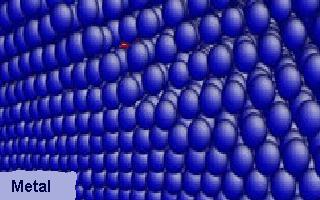
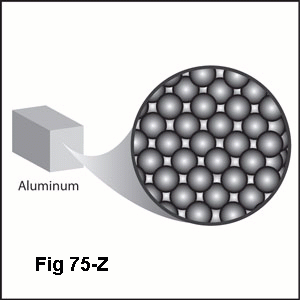
Look at the illustrations of steel and of aluminum how well these atoms are seated, all held by directional conductive movement. And so this time again I did not say; "by magnetic," did I?
For I am trying to get you to realize a difference between what we understand by magnetic, and that which acts in the same way but is more appropriately called "Conductive movement." And this time I omitted to say "Directional," since that bird belongs to all that is listed under 3M.
The M then is not directional, while the 3M is, nor is the 3W, since it is but a crux for something we have no apprehension of. Since then I revealed that the 3M is the second most fundamental force in nature, it stands to reason that there must be a first as well.
But this I leave for others to fantasize upon, seeing how man is well equipped in that matter, even as they may fantasize upon the 3W, and having baked their cookies - that I should come afterwards to correct them. Only I do not think that it will come that far, to cross that threshold.
And now for the term of "heat," like in heating a metal bar, or igniting gun powder, or the spark to ignite the gasoline. These things are just like an atomic bomb operates.
When you introduce a spark into gasoline, you, in an instant are raising the movement of a few atoms that then look to the Oxygen atom to have their party with. This they did, by looking to some atoms of O, since they were not among their kind.
But in gun-powder there are plenty of them, and so they will begin to re-organize themselves one by one. For as the movement of one is raised, it will raise the one next to it, remembering how movement is conductive.
This procedure then goes so fast that billions upon billions of them are re-arranged in a fraction of a second. Also remembering the multiplication 2, 4, 8, 16, and so forth whereby at 16.000, they are able to affect 32.000 all at once and 64,000 after that.
But it need not always be that rapid, like in heating a steel bar, the higher movement of one instigates the ones next to him and so forth till all of them turn red hot still attempting to hold onto one another.
If then we turn them white hot they will still not let go of their magnetic or conductive hold, but allow a sliding over of one another, their rigidity having being compromised. Till at last they may turn into a gas, as men do with Uranium.
But we should know all these things should we not? I now found it written quote:
"Researchers have taken one of the clearest looks at the magnetic behavior of atom-thin layers of metal. The team grew very uniform layers of cobalt and measured the direction of the magnetism inside. They found that as the thickness of the metal film increases stepwise from one to three atomic layers, its magnetism changes direction twice, by 90 degrees each time."
There is something to this is it not? For if you have one layer, the atoms are only concerned for what is next to them on their sides. But in two or three layers the center layer for sure will have to be concerned for what is above and below as well.
But how does one measure the direction of magnetism? It takes a magnet, or a sensitive electrical probe to discover the direction of any flow of magnetic. How thus they made their experiment may not necessarily conform to their explanation of it, as it is so often with mankind.
QUESTIONS
Now we must ask ourselves some questions based on the criteria that all atoms are like miniature magnets.
Q1: How come in the air the atoms of O and of N, float so free of one another, and not rather like any magnet clamp on to one another?
Q2: When we breathe we filter out the atoms of O out from the O-N. But how do the fish separate the atom of O from the H2O? Do they disengage the 2 atoms of H from it?
If so there must be many single atoms of H in the water. Or are there many of the Oxygen atoms by themselves in water?
Q3: As now all things are in movement and by movement, and all atoms spin, how do they spin? By what is it that they spin?
Q4: We are agreed that spinning movements are quite necessary in order that all matter may have its inertia. But in what all ways can or may inertia be secured?
Q5: Why is it that in metals most all of the atoms can be of the same kind, and so adhere to one another. But not so in many other substances where atoms of different ratio's come to bond?
Q6: How and why is a magnet a magnet in any order of nature? For like our earth, how or by what did that grand figure of eight come to be upon it?
And here I am speaking most fundamentally, not like saying; "O you put some electricity around it, and presto you have a magnet."
Q7: By what all ways are atoms able to bind to one another, whereby at higher temperatures they expand, while others do not? The question becomes; By what secret any two atoms will float free, or unite to each other?
Q8: Since it is obvious how in the first magnitude of nature all magnetic entities present angular movement as well as linear movement, how does all that relate to one another?
And so there are many questions to which we do not have an answer, or the answer that we do have may not be anything more than speculation. But we could make some trials if only on paper.
By Figure 75-8, is a molecule of water, the lines through them are their axis of rotation, and all three of them are turning in like direction. And so the lower atom of H has it northern pole locked on with the southern pole of the Oxygen atom. (D)
This kind of bond we can - as shown - illustrate by a dual triangle. The atom of H, at the left however is facing the atom of O at the equatorial region, like our earth is to the sun, and is held in that way. This type of bond should thus be illustrated by an X, seeing how their lines of movement there are in that fashion.
Here thus when speaking of atoms in bonding to one another there are two primary and distinct means. The first called "dual triangle," is the most common way, like south to north and visa versa. The second called the X or "crossover," is how each figure of eight is locked on to the next in electricity, and equally so in atom to atom.
The linear capacity of any single coordinate of eight then is at its own center, and not at X.
Then let us attempt to apprehend the ideal of inertia. Anything now that moves may be considered viable for inertia.
By Figure 75-7, at A, is the circle, its movement always coming back to where it was, or started, and as such is inertia. Like a spinning top, or a bullet turning in flight.
The dot in the center thereof then conveys - spinning movement, and every other dot in the illustration denotes movement in rotation. If then - at B, - we take a magnet, or our earth, a none spinning object, there are nonetheless two spinning movement upon that stationary object.
This is so since the figure eight of force is always on the move just as that circle at A, is on the move, only now that circle has become two circles, each one of them presenting a circular movement by which inertia is instigated.
Then in reference to C, we might construe it as an atom to turn either clockwise or counter-clockwise, and we end up with three spinning movement, all three of them to provide inertia.
Then by D, if we take the electrical kind for the same figure eight of force to spin around by the arrow, just as it is in and by any electrical current, we have again three spinning movement.
As then the two that make for the 3M spin at the speed of 3M, the one in the middle shall be no faster than the speed at which we turn the armature, or the number of windings put into it.
And so it is easy to see how inertia may be had with any object be it stationary or spinning. And to all of them the linear may be added for a yet greater inertia, a fourfold inertia.
When therefore we consider Figure 75-6, where we have 5 atoms of a metal, two of them bond by the dual triangle, with the other two in the X, the crossing. These bonds seem quite possible even if there be a single figure of eight upon each of these atoms.
And for inertia, so that it may serve the inclination towards gravity, there are 5 times 3 is 15 inertial movements by no more than 5 atoms. And each one is very well secured to the other, as in fact the total of their individual movements are equally as much locked into a singular pattern over the 5 of them.
And how may all this be when the atoms are drawn to, or present a multiple configuration of the eight of force, as I have illustrated at various other places? (I now said; Multiple of eight, not Multiple eights, wherein there is a difference.)
Then there is Figure 75-10, something that bears upon the formation of movement. When an object spins there is a high and low velocity, as well as zero velocity, and of course the 3M. But I promised myself not to dwell on this.
Yet this much is sure that with all the inertia one is not likely to escape from gravity.
And what more shall I pronounce when for a truth I determined to put a halt to my footsteps?
Questions and more questions. Nor do I have all the answers, but I am showing my mind so that at least we may have a start.
And yes, a start in what? In what for all reality is beyond our cunning? Because the atom in all its perfection towards everything in nature is an extremely tall order, and we know very little of it.
LINEAR TO ANGULAR TO LINEAR
Movement to movement to again movement, is that not the same as linear to angular to linear again? As then we scuff our feet upon a carpet, by the cold dry air we are creating rolling motions.
As then I said for: "Movement, to provide movement by again movement, and that even again to movement, we are entering a realm as vast as the universe. And we are too small to traverse anything as large, or as distant as all these miracles are to us.
![]() And
now without any illustration, take in
mind a circle of movement. Can you do anything with it? You can look
at it, but you cannot move it, not to the one way or the other,
since it is continually coming back to the same place over and over.
And
now without any illustration, take in
mind a circle of movement. Can you do anything with it? You can look
at it, but you cannot move it, not to the one way or the other,
since it is continually coming back to the same place over and over.
Then as you twist it by one half of a turn, now you have a cross over, a center of it by which movement passes. But even more so - by this movement into a single direction, the now two circles have their movement at any one side in like directions.
And movement of like directions being conductive, you can now move it, as well as anything else with a linear directional movement.
So you see how neat that is, and how it is not at all complicated to have linear's from angular, and again angular's from linear's?
And now how resilient are the atoms in nature, and how well can they stand up under pressures. For if we go to the bottom of the ocean where the pressure is very high, the water remains water.
That pressure there is not forcing these molecules of H2O so tightly as to convert them to something else, nor to dislodge any one atom from the other.
Or what of the molten mass within the earth, how much pressure is being exerted on these atomic magnets when the rigidity of their holding power is duly compromised, and they are forced together by the pressure of all those around them.
It seems that the only way we can disrupt atoms is by shooting at them, and then only the larger and unstable ones when there are enough of them to have a chain reaction, like as we have in our internal combustion engines, or gun powder, all of which are -"chain reactions.".
For even so the atomic bombs are no different, except to operate on the atomic level, rather than the molecular level, as gasoline or gun powder do. And even the growth of things as well as a slow decomposition of something is by a chain reaction.
Man seems to give all the credit for the power of an atomic bomb to that small package of unstable matter, while in reality it is like a cornerstone upon which a building rests. Remove it, and the whole of the building collapses. Man ought to know this from 9/11, how both towers fell while the airplanes into it were but small.
Metal as magnetic atoms set in a grid now can be ground to just grains of it, like filings, and when so, though they bond by a magnetic nature of, these filings will no longer cling to one another, as if there were no longer any magnetic nature upon them.
And the only way for us to reassemble them is to heat them to the melting point at which time they will join again magnetically. And so it is that speed, or velocity (temperature) also plays an important role in how well atoms bond to one another.
Now at last let us behold how many movements we can find with just a magnet held in our hand. By Figure 75-11, there are the following movements.
As then I do not really know what the true pattern is of number 3 and number 6, I had to illustrate something. Number 6 however illustrates the principle of dipping under whereby gravity has its way.

1. Atomic spin (induced movement)
2. Atomic directional conductive movement (a coordinate)
3. Molecular coordinates (signature, element)
4. M movement (free and directional) (M)
5. Magnetic coordinate (figures of eight) (3M)
6. Gravitational inclination (coordinate) (g)
7. Gravity (downward movement) (3M)
8. Linear movement (orbital trajectory)
9. Electrical current (rotational magnetic coordinate) (3MR)
10. Hand held movement.
ENDING WORDS
I am not at all happy about the fact that I had to scold man, and that on occasion in anger I may have been too rough or too stern, for so it is written; "Be angry, but sin not." And that lies heavy upon me, for my wrath is quickly kindled. Yet so at all times we must remain with wisdom.
Moreover, it is written; "And he will call upon "My" name." Therefore in whatever I do or say, the honor of my Father, the God of all ages is likewise at stake. And in my love for Him I will grant Him all honor, and not be the instrument of any dishonor to Him.
As then the spirit is willing, but the flesh is weak, I am as yet in this flesh, and O how it bears down upon me, like as in living with myself I live with what I dislike. If then I am looked upon for having knowledge and wisdom, it is of my Lord and my Father.
But now I must put an end to all this, to speak no more than what I have already said. For I have spoken more than had I planned to speak.
And let it be sufficient that man has at least come to know some of nature's fundamentals. Like the foundation upon which the earth rest and whereby his feet are kept upon the ground along with the reality of what his electricity and magnetism consist of.
And what more does man wish to know? How the tides come about, and how the days of the year are numbered in the orbital track of his earth around the sun? These also have been awarded him along with the manner of light and a number of other things of which I have spoken.
Since then these pages are written over a period of fifty plus years, in the beginning of those years I in some things sided with the definitions adopted by man. And as the years passed in questioning these very things I came to better them as I went along, without erasing the previous.
But even more so in the past, and even up till this day I utilized man's terms like electrons and protons etc., simply for education, and not as if I believed in them. For there are many ways in which to teach, and so I did along with its revelations.
As then truth show untruth for the lie that it is, so the evidence of what is real all in itself mocks that which is unreal.
Yet I also came to scorn the wise, not for their ignorance of the truth, but for the pride and arrogance of their heart and lips. It was with due intend that I made many from among men out for fools, all because they are, and deserve to be known for what they are.
They should not have made a mockery of God, and of His creation, nor should they have pronounced their filthy speech against the Majesty of the great Creator. With that they only angered me, and provoked me to lash out at them.
I am one who loves, and hate as well. Loving all that is righteous, and hating all that is unrighteous. And both of these have settled within me with a passion.
![]()